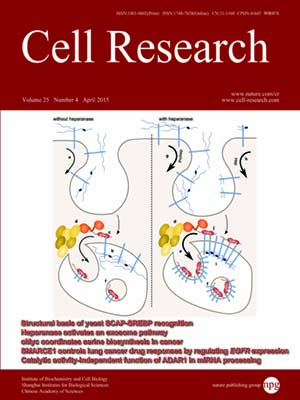
Volume 25, No 4, Apr 2015
ISSN: 1001-0602
EISSN: 1748-7838 2018
impact factor 17.848*
(Clarivate Analytics, 2019)
Volume 25 Issue 4, April 2015: 401-411 | Open Access
ORIGINAL ARTICLES
Structure of the WD40 domain of SCAP from fission yeast reveals the molecular basis for SREBP recognition
Xin Gong1,2,*, Jingxian Li1,2,*, Wei Shao3,*, Jianping Wu1,2, Hongwu Qian1,2, Ruobing Ren1,2, Peter Espenshade3 and Nieng Yan1,2
1State Key Laboratory of Bio-membrane and Membrane Biotechnology, Beijing 100084, China
2Center for Structural Biology, Tsinghua-Peking Joint Center for Life Sciences, School of Life Sciences and School of Medicine, Tsinghua University, Beijing 100084, China
3Department of Cell Biology, Johns Hopkins University School of Medicine, Baltimore, MD 21205, USA
Correspondence: Nieng Yan,Peter Espenshade(nyan@tsinghua.edu.cn;peter.espenshade@jhmi.edu)
The sterol regulatory element-binding protein (SREBP) and SREBP cleavage-activating protein (SCAP) are central players in the SREBP pathway, which control the cellular lipid homeostasis. SCAP binds to SREBP through their carboxyl (C) domains and escorts SREBP from the endoplasmic reticulum to the Golgi upon sterol depletion. A conserved pathway, with the homologues of SREBP and SCAP being Sre1 and Scp1, was identified in fission yeast Schizosaccharomyces pombe. Here we report the in vitro reconstitution of the complex between the C domains of Sre1 and Scp1 as well as the crystal structure of the WD40 domain of Scp1 at 2.1 Å resolution. The structure reveals an eight-bladed β-propeller that exhibits several distinctive features from a canonical WD40 repeat domain. Structural and biochemical characterization led to the identification of two Scp1 elements that are involved in Sre1 recognition, an Arg/Lys-enriched surface patch on the top face of the WD40 propeller and a 30-residue C-terminal tail. The structural and biochemical findings were corroborated by in vivo examinations. These studies serve as a framework for the mechanistic understanding and further functional characterization of the SREBP and SCAP proteins in fission yeast and higher organisms.
10.1038/cr.2015.32
FULL TEXT | PDF
Browse 2576


